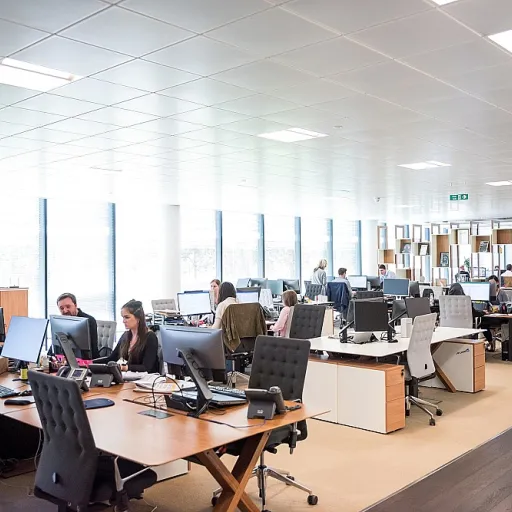
Defining an Intelligent Workplace
The Essence of an Intelligent Work Environment
In an era where the digital landscape shapes the way we work, defining an intelligent workplace has become increasingly important. An intelligent workplace is not just about integrating cutting-edge technology; it's about fostering a conducive environment where employees thrive, communicate easily, and manage tasks effectively. An intelligent work environment leverages state-of-the-art workplace technologies and data-driven tools to facilitate seamless operations. From advanced room booking systems to comprehensive digital tools, every element is orchestrated to enhance productivity within hybrid work settings. Central to this concept are solutions that provide employees with smart systems for efficient task management and real-time collaboration. Tools utilizing data analytics and cloud computing offer valuable insights that inform decision-making and track performance. Moreover, technologies like machine learning contribute to developing adaptive offices that respond dynamically to employees' needs. Balancing technology with employee well-being is key. Employee experiences are enhanced when workplaces adapt flexibility, ensuring that people remain at the core of workplace design. An intelligent work environment supports both traditional and remote employees, providing space and tools that cater to varied work styles and preferences. For a deeper understanding of how HR plays a pivotal role in crafting such environments, explore how HR supports remote work initiatives. This interplay forms the backbone of an intelligent workplace where technology and human-centric strategies coalesce to shape the future of work.Technology as a Backbone
The Role of Technology in Shaping Workplaces
In today's rapidly evolving work environment, technology serves as the backbone of an intelligent workplace. It is the driving force that transforms traditional offices into dynamic, adaptable spaces. The integration of digital tools and smart systems is not just about keeping up with trends; it's about creating a seamless employee experience that enhances productivity and fosters innovation.
One of the key elements in this transformation is the use of cloud computing and data analytics. These technologies allow for real-time data management and provide insights that can be used to optimize workflows and decision-making processes. By leveraging machine learning, organizations can predict trends and adapt to changes swiftly, ensuring that the workplace remains efficient and effective.
Moreover, collaboration tools are essential in supporting hybrid work models. They enable employees to communicate and collaborate regardless of their physical location, breaking down barriers and fostering a culture of inclusivity. Tools like desk booking and room booking software streamline the use of office space, making it easier for teams to coordinate and work together efficiently.
Implementing these workplace solutions not only improves the work environment but also plays a crucial role in visitor management and task management. By automating routine tasks, employees can focus on more strategic initiatives, ultimately driving the organization towards its goals.
For more insights on how technology is reshaping the dynamics of work, you can explore the dynamics of work and more.
Flexibility and Adaptability
Adopting Agile Practices and Open Workspaces
In an ever-evolving work environment, the need for flexibility and adaptability is paramount. Hybrid work models and advancements in workplace technology are reshaping how companies operate and manage their teams. To create an intelligent workspace that caters to diverse employee needs, it's essential to integrate systems that offer real-time solutions tailored for dynamic tasks. One of the crucial aspects of a smart workplace is the deployment of digital tools that support agile work practices. These tools allow employees to switch seamlessly between different tasks and spaces, enhancing productivity and promoting an adaptive work culture. Hybrid work setups, incorporating both remote and in-office work, demand a level of flexibility that can only be achieved through intelligent design and technology. An intelligent workplace leverages a combination of desk booking systems, collaboration tools, and visitor management solutions that streamline operations and foster an environment conducive to teamwork. Data-driven technologies like cloud computing and machine learning provide the backbone for these systems, ensuring that employees have the resources they need at their fingertips. The integration of data analytics into workplace solutions also plays a pivotal role in enhancing the employee experience. By analyzing employee feedback and usage data, companies can optimize their office layouts and digital resources to better support productivity and well-being. Furthermore, the use of room booking and booking software not only optimizes space management but also encourages spontaneous collaboration by facilitating easy access to meetings and group work areas. Effective management of these systems enables businesses to remain agile, adjusting to changing circumstances and enhancing overall workplace intelligent capabilities. For those interested in exploring how humor can be part of this adaptable and evolving work environment, Exploring the Humor in Remote Work Titles offers an insightful perspective on the lighter side of hybrid work dynamics.Fostering Collaboration and Communication
Building Bridges with Technology
In an intelligent workplace, fostering collaboration and communication is paramount. The modern work environment thrives on seamless interaction between employees, whether they are in the office or working remotely. Digital tools and technology play a crucial role in bridging the gap, enabling teams to collaborate effectively regardless of their physical location.
Collaboration tools such as cloud computing and data analytics systems allow employees to work together in real time, sharing insights and data effortlessly. These tools not only enhance productivity but also ensure that everyone is on the same page, reducing the chances of miscommunication.
Creating a Collaborative Culture
While technology provides the backbone, the culture of collaboration must be nurtured within the organization. Encouraging open communication and providing platforms for employees to share ideas can significantly enhance the employee experience. This involves integrating smart workplace solutions like room booking and desk booking systems, which streamline the management of physical spaces and make hybrid work more efficient.
Moreover, intelligent workplaces leverage machine learning and digital tools to tailor communication strategies, ensuring that the right message reaches the right people at the right time. This targeted approach not only saves time but also fosters a more engaged and informed workforce.
Enhancing Employee Interaction
Effective collaboration is not just about technology; it’s about creating an environment where employees feel connected and valued. Intelligent workplaces focus on enhancing employee well-being by providing tools that facilitate easy interaction and task management. Visitor management systems, for instance, can streamline the process of welcoming guests, allowing employees to focus on more critical tasks.
By prioritizing collaboration and communication, intelligent workplaces not only improve the work environment but also drive innovation and success. As organizations continue to adapt to the changing landscape, the integration of smart workplace technology will be key to maintaining a competitive edge.
Enhancing Employee Well-being
Promoting a Balanced Work Environment
An essential component of intelligent workplaces is enhancing employee well-being. A truly intelligent work environment goes beyond utilizing digital tools and technologies to solely boost productivity; it also focuses on fostering a positive and healthy space for employees to thrive both professionally and personally. In today's hybrid work settings, the mental and emotional health of employees can be supported by thoughtful workplace solutions. Consider the implementation of digital tools that offer real-time support, such as meditation apps or virtual health sessions, which provide a respite from the daily grind. Bullet points:- Incorporate room booking systems and desk booking software to ensure employees have access to suitable workspaces tailored to their needs.
- Utilize analytics and data to understand employee engagement and satisfaction, ensuring that decisions about workspaces are data-driven and effectively meet the needs of employees.
Measuring Success in an Intelligent Workplace
Evaluating the Effectiveness of Intelligent Workplaces
Determining the success of an intelligent workplace involves a combination of qualitative and quantitative assessments. Companies need to identify key performance indicators (KPIs) that reflect the effectiveness of their intelligent work systems and support their overall business objectives.- Employee Productivity: One significant measure of success is the impact on employee productivity. Effective use of digital tools and collaboration technologies should enable employees to complete tasks more efficiently in a hybrid work environment. Workplace solutions such as task management and desk booking systems can provide necessary data.
- Employee Satisfaction: The well-being of employees is paramount. Collecting feedback through surveys or digital tools for employee experience can provide insights into the level of satisfaction with the work environment. A smart workplace should foster comfort and engagement, improving overall job satisfaction.
- Technology Utilization: Evaluating the utilization rates of various workplace technologies is crucial. Tools like room booking and visitor management software should streamline operations, contributing to a more organized office environment.
- Seamless Collaboration: An intelligent workspace should facilitate real-time collaboration among team members. By analyzing the use of collaboration tools, companies can gauge how well employees are able to work together across different locations.
- Cost Efficiency: Implementing and maintaining intelligent systems should ultimately lead to cost savings. This can be measured by tracking reductions in office space expenses, efficient use of resources, and maintenance costs over time.
- Data-Driven Insights: The implementation of systems such as cloud computing and data analytics can provide valuable insights for continuous improvement. These technologies enable companies to make data-driven decisions that optimize work processes.
- Adaptability to Change: Finally, an intelligent workplace should demonstrate the capacity to adapt to new challenges and changes in the work environment. This includes integrating new technologies or changing workplace strategies in response to fluctuating business needs.












